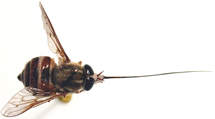 The fly family Tabanidae (horse flies) includes an estimated 4500 extant species distributed throughout the world. Nearly all are blood-feeders as adults, but many are also important pollinators of angiosperm flowers. The biology and taxonomy of horse flies has an important historical legacy, but modern phylogenetics-based revisionary work has lagged behind other dipteran groups due to a generational reduction in the number of horse fly taxonomists and to a perceived "difficult" morphology which is often homogeneous for many standard dipteran characters (e.g., male genitalia) and/or highly adapted in others (floral-associated features). Current classifications are heavily biased by several large traditional genera, while many smaller groups need to be addressed to provide context and new characters from which more comprehensive phylogenetic revision can proceed.
The fly family Tabanidae (horse flies) includes an estimated 4500 extant species distributed throughout the world. Nearly all are blood-feeders as adults, but many are also important pollinators of angiosperm flowers. The biology and taxonomy of horse flies has an important historical legacy, but modern phylogenetics-based revisionary work has lagged behind other dipteran groups due to a generational reduction in the number of horse fly taxonomists and to a perceived "difficult" morphology which is often homogeneous for many standard dipteran characters (e.g., male genitalia) and/or highly adapted in others (floral-associated features). Current classifications are heavily biased by several large traditional genera, while many smaller groups need to be addressed to provide context and new characters from which more comprehensive phylogenetic revision can proceed.
A US National Science Foundation PEET (Partnerships for Enhancing Expertise in Taxonomy) project DEB 0731528 Taxonomic, Phylogenetic, and Evolutionary Studies of Horse flies (Diptera: Tabanidae): An Integrated Approach to Systematics Training is working to expand the knowledge of this group.
Although horse flies are one of only a few flies that can be named by the average layman, surprisingly little is known about this group worldwide. You can read about tabanids that are known as the beautiful, bloodsucking pollinators ... what the Wikipedia says about tabanids, plus information on their ecology, veterinary importance, and control from Rob Hutchinson and their health risks. We invite you to help us expand the knowledge of this very diverse group of flies.
